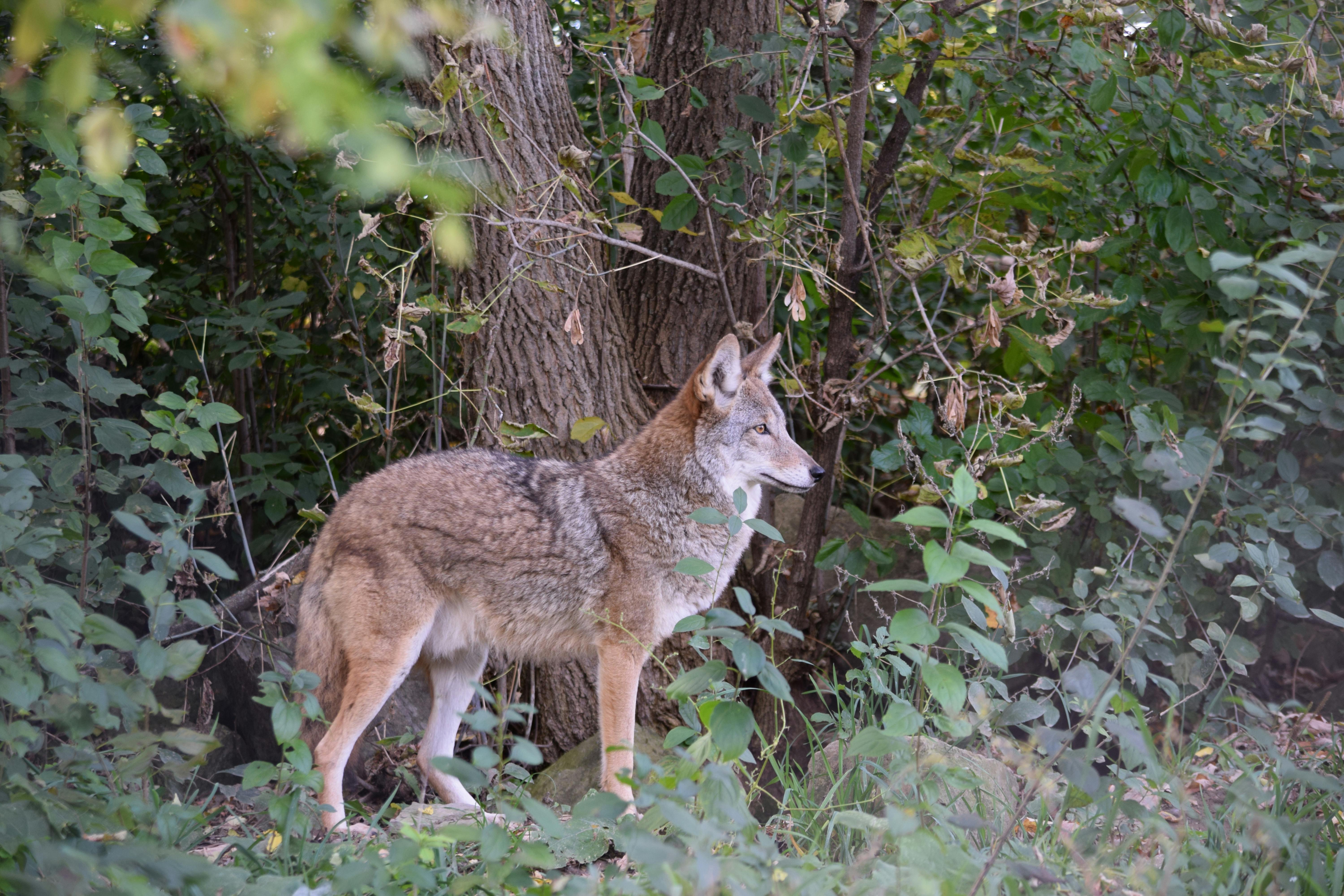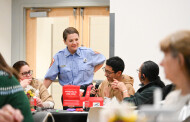Ahhh, the days are getting longer, sunnier and warmer. Time for a little yard work! You head outside, start raking back pine needles to reach the weeds and are startled by what you discover. There, nestled together near the base of a shrubbery trunk, are tiny, practically hairless little creatures. After the initial shock, you realize they’re bunnies — very young baby bunnies. They look helpless and your next thought is, where is the mother?
If this or a similar situation happens to you, resist your next thought and instinct. The animal most likely does not need rescuing.
“The initial best possible thing to do is to not interfere,” said Falyn Owens, a wildlife extension biologist with the North Carolina Wildlife Resources Commission (NCWRC). Owens specializes in outreach and education that addresses human and wildlife interaction.
From a songbird in your tree and deer along your back fence to dumpster-diving raccoons and a fox running across the street, human and wildlife interactions happen every day. And in areas with active suburban development, interactions are likely to increase. Owens offered some insights about this, as well as tips for peacefully coexisting with our animal friends.
“Certainly, reports and requests for help about human and wildlife interactions are increasing and there are a lot of reasons for that,” Owens said. “One, especially here in North Carolina, is our human population is increasing so there are more people out there to interact with wild animals. She added, “The actual proportion of human populations that live in cities and suburbs versus rural areas have been increasing for decades, so more and more people are not brought up familiar with the local wildlife.”
Owens explained that typically people who grow up in rural settings experience wildlife all the time and they learned how to handle these interactions. For a lot of people living in the suburbs, though, this education is missing. “People talk about common sense as being this universal truth, that everybody has this intuitive common sense,” she said. “In reality, the common sense that we all have is based on our experience growing up. What might be common sense in terms of dealing with wildlife if you live in a rural area is usually completely different from the common sense you have if you grew up in a city or suburb.
The NCWRC often receives calls from people concerned after an animal encounter, not realizing that the species is common where they live, especially when it comes to mammals. “We get a lot of reports of people being surprised that there’s a fox in their backyard, or a coyote in the neighborhood, or a huge flock of geese hanging out in the retention pond in their neighborhood. Also, raccoons, opossums, squirrels — when there are too many [squirrels], or too few for someone’s preference — and songbirds as well, especially during the breeding season when birds are having their young and people are finding those young birds on the ground as they are learning to fly.”
So, what should you do if you find a baby bird, a burrow of bunnies or other young wildlife?
“In a lot of cases, people run into young animals, they don’t see adults nearby and they automatically assume, ‘Oh, it must be abandoned. It must be orphaned, and I must take it in my house and take care of it,’” said Owens. “But, the fact of the matter is, that many wild animals leave their young for hours at a time while the adults go foraging for food, or hunting, or going to get a sip of water somewhere else.” Owens pointed out this is particularly true with deer, rabbits and birds. “A person thinks they are helping, and they take this animal in. And, in a lot of cases, that poor young animal ends up dying because it isn’t getting the care it needs since it’s no longer being cared for by its parents.”
Owens said the first thing anyone should do if they find a young animal is back up, leave it alone and assume everything is normal and the animal is okay. Leaving the baby alone is also the best way to avoid any confrontation with its parent that may be watching from nearby. If you’re concerned something is wrong with the animal, contact a wildlife professional who can help assess the situation.
There is one mammal in particular that raises a lot of questions among the general public — coyotes. Is it uncommon to see them in North Carolina and Wake County? Is a sighting a concern?
Historically, coyotes, which are native to the Midwest and western U.S., weren’t our wildlife neighbors. Owen said that all changed in the 1980s. “Coyotes have done extremely well,” Owens said. “They benefited from a whole bunch of the things that human beings do to the landscape. And, so, coyotes have spread basically to the point that they are in every single state.” When coyotes first arrived in North Carolina, a sighting would be rare simply because they weren’t as common. But, as the species established itself and its population rose, sightings followed suit. The coyote population has since leveled off over the last decade or two. “We see times when reported sightings and complaints about coyotes will go up, but usually it’s on a seasonal basis, based on how coyotes are behaving, like when they are raising pups, and they are hunting more. People see coyotes more because they are up at all hours to find enough prey to feed their pups. So, we see this fluctuation on a seasonal basis, but year-to-year the number of coyotes is pretty stable.”
If you see a coyote, be cautious and take stock knowing they don’t want to hang around humans. “In the vast majority of instances, they are not a threat to human beings,” Owens said. “They notice us and are curious about us, but they don’t want to interact with us. Coyotes are very well aware that humans are much bigger than they are and they just want to be left alone by us even if they are watching to see what we do. They might pay attention, but they are trying to figure out if we’re a threat to them and they need to run away or if they can go about their business and ignore us.”
A coyote is a threat to small dogs, however. “If you have a small dog, especially a toy breed dog that is roughly the size of a coyote’s normal prey, they should always be close by even if they’re on a leash,” she said. “Coyotes are afraid to approach a human, but a tiny dog unsupervised all by itself might look like a tasty snack and we don’t want to put our pets in that situation.”
Seeing certain wildlife, especially opossums and raccoons, during the day is another concern the NCWRC often hears from the general public. People automatically assume the animal has rabies, but that’s usually unfounded. “We deal with that question a lot,” said Owens, adding that a raccoon or opossum being out in the day is not a good indicator of rabies. She explained that an opossum’s immune system and physiology help prevent a rabies infection. “It’s extremely rare for them to develop the disease. If an opossum is active during the day, rabies would be the last explanation I would consider.”
And, if you see a raccoon eating from your trash can during the day, it’s not rabid, it’s hungry. “Animals with rabies don’t eat,” she said. “They are dying from a significantly fatal disease. They’re not going to be in the trash can eating an old hamburger. Usually, if an animal is scavenging on food that has been left in the yard, even if the animal is out in the daytime, that’s a pretty good sign that animal is healthy and doing exactly what it would under normal circumstances.”
Opossums and raccoons are nocturnal, but sometimes they just need to be awake during the day. They have things to do! As Owen pointed out, “nature doesn’t abide by our neat little, tidy categories very well.” These animals have numerous reasons to be awake, especially when raising their young. And just like human babies, animal young don’t sleep regularly during the day or night. “Mom is up at all hours trying to take care of them and find food for them,” she said. “So, if you see one in the daytime, it’s spring or summer and those raccoon moms are working hard to take care of their young. It has nothing to do with rabies.”
When an animal is sick with rabies, it will exhibit unusual behavior because of the disease’s effect on the brain. “Rabies causes the brain to shut down and die, ultimately leading to death,” Owens pointed out. “This appears as neurological symptoms like seizures, lack of muscle control and paralysis. Animals with rabies are often seen compulsively licking or biting at the air or inanimate objects and may drool due to loss of control of their throat muscles. Regardless of the exact behavior, an animal with rabies often appears to have some extent of brain damage… Animals showing these signs should be avoided, and if any direct contact occurs, the county health department should be notified immediately.”
One of the best ways to mitigate an unwelcome wildlife interaction has to do with food. If you don’t want wild animals in your yard or close to your home, then make sure they don’t have access to food. “Food is an attractor,” said Owens. “Animals are out there trying to survive, and they remember where they found food and they will come back over and over to a place where they found food before.” Any food left outside, including food for a dog or cat, will attract wild animals. Even a bird feeder is a beacon. “Those are calories, so those food sources are going to attract any number of animals that are just trying to survive and are going to come to the easiest place they can to get food,” Owens explained.
Using a bird feeder as an example, Owens said deer, squirrels, mice, rats, raccoons — and even bears — will eat bird seed. And, attracting small rodents, like mice, to a bird feeder can then attract the predators of those animals. “You can’t really control what comes to a bird feeder because it’s really not bird food, it’s animal food.”
To avoid your home being a wild animal’s favorite restaurant, Owens suggests not putting food scraps in compost piles or leaving pet food outside and making sure you keep your trash can closed with a heavy, secured lid.
Humans feeding wild animals is a particular concern for deer. When humans put out food for deer, it will attract them from a wide area, and this can result in multiple negative outcomes. “Feeding [deer] is a good way to slowly cause the increase of the local deer population,” Owens said. “Over enough time, over enough years, that can lead to increased reproduction. So, you actually have a higher deer population over time and that can lead to situations where the environment naturally can’t support that number of deer anymore. And, so you have issues — you suddenly stop feeding them and all of a sudden the deer don’t have enough food.”
Owens said this can also create a nuisance situation among neighbors. “Maybe the person feeding the deer loves the deer and doesn’t mind that there are a lot of deer in their yard. But maybe their neighbor has a really expensive rose garden that they manage, and they can’t keep roses anymore because the deer are eating all of their plants. So, we get these conflicts of interest where one person is creating a situation where there are way more animals than naturally occurring in a small area and everybody else is paying the price in the surrounding area, which is not good. It’s not good for the deer either.”
Humans providing “deer corn” is also a bad idea. “They are very happy to eat it,” Owens said. “It’s kind of like junk food for them. It’s tasty and fills their stomach, but it can cause issues with acidosis. It can actually make them sick. It’s much, much healthier for them to eat natural vegetation.”
Owens said acidosis, specifically rumen acidosis, is a condition that occurs when a deer eats too many carbohydrates, which is not something they get much of in their natural diet. These carbs adversely affect their gut flora to the point they can no longer digest food. In addition to causing acidosis, feeding deer can also lead to other problems, such as a toxic bacterial infection.
Another concern is caused by contaminated “wildlife feed.” Owens explained that deer corn is often corn deemed unsafe for people or livestock to eat. This corn could be infected with a type of mold that produces harmful toxins, which can cause organ damage or reproductive issues in deer and prove lethal to turkey, quail, and songbirds.
Spreading disease is also a possible outcome of humans feeding deer and other animals. “One of the other really harmful consequences of feeding [wild] animals is that when you concentrate them in a small area, because you are attracting them to one location, that can be a recipe for spreading contagious diseases. And one of those dangerous diseases for deer is chronic wasting disease (CWD).”
CWD is a fatal, neurological disease, similar to mad cow, Owens explained. It’s 100% fatal, causing holes in the brain, and deer literally waste away until they die. Putting out food is like ringing a giant dinner bell. When deer are enticed to gather in a small area, groups that would not normally interact come in contact with each other. The deer leave behind saliva and droppings in these gathering spots, which accumulate and make spreading disease more likely.
Another contributing factor to the spread of CWD is people transporting deer and deer parts. For this reason, Owens said the NCWRC has done a lot of work to educate hunters and implement regulations around testing harvested deer. Currently, CWD is not in Wake County, but it is in areas not that far away. “We don’t know what the future holds, but not too far south of Wake County we have found some CWD. We are keeping track the best we can, but you can never 100% know. We just haven’t found it in the area yet.”
Securing buildings is another tip Owens offered when it comes to wildlife. Squirrels and bats in attics, a fox den under a shed are all examples of situations that increase the likelihood someone will happen upon a wild animal. The close proximity simply increases the odds. “We can prevent those types of situations by making sure that our buildings are repaired well, and they don’t have openings that allow animals to have access.”
If an animal decides to make your home theirs, or you have questions about what’s normal animal behavior or how to deal with a wildlife related problem, Owens suggests calling the NCWRC’s wildlife helpline. “We have biologists who will answer any questions people have and get them the information to help make the right decision,” she said. “They can speak to a wildlife biologist and get real advice — if they should do nothing, if they should try to intervene in some way or if they should call a professional. They can get those questions answered.” A professional is specifically a wildlife control agent. Agents are licensed through the state to handle nuisance situations, such as bats in a home.
For concerns over an injured animal, leave it alone and call the NCWRC’s helpline or contact a licensed wildlife rehabilitator before taking any other action. The NCWRC website includes a list of licensed rehabilitators throughout the state.
As a biologist with the NCWRC, Owens said she aims to share common sense tips and education, so people interact with wild animals responsibly. One of her main tips is pretty simple: Leave animals alone.
“In a lot of cases, we can prevent a lot of problems by leaving wild animals alone. Don’t approach them, corner them, or try to capture them or harass them. They don’t really want to interact with us. They just want to go about their day, living their lives. We can certainly coexist with them as long as we don’t put them into a situation where they are causing a problem for us.”
Have a wildlife question or want to know more about the animals in your area? Check out the following NCWRC resources and other organizations for online and in-person educational opportunities.
NCWRC: The wildlife helpline is 866-318-2401. The commission’s website, www.ncwildlife.org, offers a wealth of information, including details about species across N.C. To find a Wildlife Control Agent or a Licensed Wildlife Rehabilitator and their contact information, go to the commission’s homepage, click on “Connect” and then scroll to “Have a Wildlife Problem?” Here you’ll find a searchable map for control agents by county. There is also a searchable database of rehabilitators by location and the animal(s) they specialize in.
South Wake Conservationists: A local North Carolina Wildlife Federation chapter, this non-profit organization is dedicated to conserving and improving wildlife habitat and diversity through projects and public outreach. The group hosts a variety of community events, such as bird walks and beautification work at local schools. Meetings are open to the public and often feature guest speakers. For more information, visit www.southwakeconservationists.org.
Harris Lake County Park: The park offers online and in-person programming for children and adults, such as Citizen Science Thursday when participants join lake staff in exploring and identifying plants and animals. To learn more, call 919-387-4342 or visit www.wake.gov. (Click on “Living & Visiting” then “Recreation & Learning” where you’ll find a listing of parks. Once on the Harris Lake webpage, click “Programs & Events” and then “Public Programs”).








